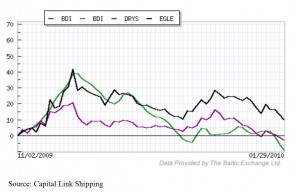The Baltic Dry Index is a shipping price index created by the London based Baltic Exchange. It measures changes in prices of transporting dry bulk cargo such as grain, cocoa, phosphates, fertilizers, animal feed, oil, coal, iron ore and metal by sea. The Baltic Dry Index is calculated by taking the time charter components of the Baltic’s capesize, panamax, supramax and handysize indices (Baltic Exchange). Multiple geographic routes are taken into consideration in the calculation of all indices.
The Baltic Dry Index is considered an excellent gauge of global trade. The Baltic Dry Index measures the demand and supply of dry bulk shipping capacity. An increase in demand for dry bulk shipping capacity indicates growth in trade of bulk cargo which is often raw material for intermediate or finished goods. This points to growth in consumption and general economic health. The Baltic Dry Index is considered an impartial leading indicator (predictor of future economic activity) because it is free from speculation. Nor is it subject to many adjustments and revisions. The Baltic Dry Index indicates the real demand and supply for dry bulk cargo space. Only those who have cargo to ship will buy space and anyone with the available space would supply it because it’s very costly to keep an idle ship.
There are many ways in which we can use the Baltic Dry Index. As discussed it’s a good leading indicator and can be used to get an idea about future economic activity. We can also use it to forecast demand for commodities. A rising Baltic Dry Index signifies improving demand for commodities. As such we can look at the type of commodities that are being demanded and invest in companies producing them. Increased demand is also good news for major commodity exporting countries such as Canada, Australia and New Zealand.
The Baltic Dry Index is directly indicative of the dry bulk shipping market and we can make use of it to enter or exit from positions in dry bulk shipping companies. The following chart compares the performance of the BDI with two bulk shipping companies; Dry Ships and Eagle Bulk.
However, different companies have varying exposure levels to the Baltic Dry Index. Companies that have most of their ships contracted out at the spot time charter equivalent have a higher level of exposure to the index than those that have most of their ships contracted out on period time charter. Spot charters will yield more profit to the shipper when the Baltic Dry Index is increasing and lower profits when it’s decreasing. On the other hand period time charters that are contracted out at a fixed daily rate have less exposure to the Baltic Dry Index and will yield lower profits when the Baltic Dry Index increases more than the spot charters but they will be less volatile, will hedge the risk and guarantee cash flows when Baltic Dry Index rates fall. It is also important to get an idea of a company’s list of bulk vessels on order and the delivery time line. Ship delivery has a long lead time. If the ships are to be delivered well in the future; it may to be too late to make use of the high demand for dry bulk shipping capacity.
The Baltic Dry Index is very sensitive to changes in the demand and supply equation because it takes a long time to build a ship and supply is tight and inelastic. Bunker prices, weather patterns that creates increased demand for energy creating raw material, congestion at ports and major shipping gates (e.g. Suez canal), and piracy all exert upward pressure on the index. As the BDI is calculated in US Dollars and changes in the Dollar too have an effect.
This article was written by Gayani S. B.Sc., CFA, ACMA an ex-investment banker with experience as an analyst in the shipping sector.









